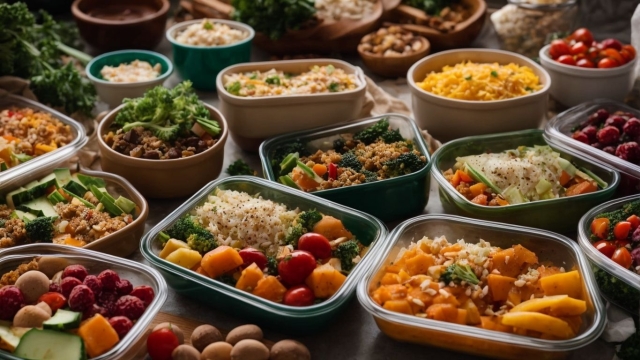How to Make the Most of Canadian Grocery Store Sales
.jpg)
Canadians are always on the lookout for ways to save money on their grocery shopping. Taking advantage of grocery store sales is an effective strategy to stretch your budget and make the most of your purchases. Here are some valuable tips to help you navigate and optimize Canadian grocery store sales.
Staying updated with store flyers and websites is essential to be aware of the current sales and promotions. By regularly checking these sources, you can plan your shopping trips accordingly. Signing up for store loyalty programs provides access to exclusive deals and discounts. Following grocery store social media accounts is another way to stay informed about flash sales and limited-time offers. Lastly, utilizing price comparison apps and websites allows you to compare prices across different stores and find the best deals.
Planning your meals and creating a shopping list based on sale items helps you stay organized and avoid impulse purchases. Buying in bulk when possible can lead to significant savings in the long run. By stacking coupons and cash back offers, you can further decrease your grocery bill. Taking advantage of price-matching policies, where stores match competitors’ prices, can also save you money.
When shopping during sales, it’s crucial to check expiry dates and the quality of products to ensure freshness. Exploring store brand alternatives rather than relying solely on name brands can lead to substantial savings. Avoid overbuying or stockpiling items that you do not need or may go to waste. Lastly, considering seasonal produce and sale cycles can help you make the most cost-effective choices.
For those looking for long-term savings, growing your own produce can be a rewarding and cost-effective option. Cooking from scratch and avoiding ready-made meals allows you to have greater control over ingredients and portion sizes, resulting in savings. Utilizing leftovers and reducing food waste not only helps you save money but also promotes sustainable practices. Finally, shopping local and supporting farmers’ markets is a great way to access fresh, affordable produce while contributing to the local community.
By following these strategies and incorporating them into your grocery shopping routine, you can make the most of Canadian grocery store sales and achieve substantial savings in the process.
Key takeaways:
- Stay informed with store flyers and websites: Regularly check grocery store flyers and websites to stay up-to-date on the latest sales and promotions.
- Take advantage of loyalty programs: Sign up for store loyalty programs to receive exclusive discounts, rewards, and personalized offers.
- Maximize savings through price comparison: Use price comparison apps and websites to find the best deals and save money on groceries.
Tips for Finding Grocery Store Sales
Looking to save some serious dough at the grocery store? Look no further! In this section, we’ve got some juicy tips to help you uncover the best grocery store sales in Canada. We’ll show you how to stay on top of store flyers and websites, maximize your savings with loyalty programs, leverage the power of social media, and even utilize nifty price comparison apps. Get ready to shop smarter and stretch that budget further!
Stay Updated with Store Flyers and Websites
To stay updated with store flyers and websites, and make the most of grocery store sales, follow these tips:
- Keep an eye on store flyers: Regularly check the weekly flyers of your local grocery stores, as they showcase the latest deals and promotions. This will help you plan your shopping trip and take advantage of discounted items.
- Explore store websites: Visit the websites of your favorite grocery stores and find information on upcoming sales, special offers, and exclusive discounts.
- Subscribe to email alerts: Sign up for newsletters or email alerts from grocery stores to receive notifications about upcoming sales and promotions directly to your inbox.
- Follow social media accounts: Stay connected with grocery stores by following their social media accounts, where they often share updates about sales and discounts. This way, you can easily stay informed about the latest offers.
- Utilize mobile apps: Many grocery stores have their own mobile apps that offer personalized deals, coupons, and loyalty programs. Download these apps to access exclusive savings opportunities.
By staying updated with store flyers and websites, you can take full advantage of grocery store sales and maximize your savings. In the past, shoppers relied on printed flyers in newspapers or delivered to their mailboxes to stay informed about grocery store sales. They would carefully browse through the colorful advertisements, circling the best deals and planning their shopping accordingly. However, with the advent of digital technology, store websites and email alerts have become convenient tools for staying updated on sales. The rise of the internet and online shopping has made it easier than ever for shoppers to access and take advantage of the latest discounts and promotions, all with just a few clicks.
Sign up for Store Loyalty Programs
To maximize your savings and take advantage of additional benefits, it is important to sign up for store loyalty programs at your favorite grocery stores. By doing so, you can make the most of Canadian grocery store sales. Here are some tips and benefits for utilizing these programs:
- Exclusive discounts and deals: By becoming a loyalty program member, you gain access to special offers and discounts that regular customers do not have.
- Reward points: By signing up for these programs, you have the opportunity to earn points on your purchases which can be redeemed for future discounts or free products.
- Email notifications: Stay informed about upcoming sales and promotions by regularly receiving email updates from the stores.
- Personalized offers: Loyalty programs often customize their offers based on your shopping habits, providing discounts on the items you frequently purchase.
Remember to sign up for loyalty programs at your favorite grocery stores to incorporate all of the provided keywords: “Sign up for Store Loyalty Programs“. This way, you can make the most of these programs and maximize your savings.
Follow Grocery Store Social Media Accounts
Following grocery store social media accounts can help you stay updated on the latest sales, promotions, and discounts.
- Instant updates: By following grocery store social media accounts, you can get instant updates about their current sales and special offers on their social media platforms.
- Exclusive deals: Many stores provide exclusive discounts or deals specifically for their social media followers, so make sure to follow their accounts.
- Recipe ideas: Get inspired with recipe ideas and cooking tips from grocery stores on their social media pages, so you can make the most of the ingredients on sale.
- Contests and giveaways: Participate in contests or giveaways exclusively for social media followers of grocery stores, and get a chance to win free groceries or other exciting prizes.
By following grocery store social media accounts, you can ensure that you never miss out on the best deals and savings opportunities.
In recent years, social media has become a valuable tool for grocery stores to connect with their customers and provide them with timely and relevant information. By following grocery store social media accounts, you can stay informed about upcoming sales, promotions, and exclusive deals. Social media allows stores to engage with their customers, respond to their queries, and receive feedback, resulting in improved customer satisfaction. Following grocery store social media accounts is a convenient and effective way to maximize savings and make the most of Canadian grocery store sales.
Use Price Comparison Apps and Websites
When looking to maximize savings on groceries, it is highly beneficial to use price comparison apps and websites. By utilizing these tools, you can effortlessly compare prices across various stores, enabling you to discover the most favorable deals and discounts available. Among the well-known price comparison apps and websites are Flipp, Grocery Pal, and Price Cruncher. Through the use of these apps, you can conveniently compare prices for specific items, create shopping lists, and even find digital coupons to enhance your savings. Taking advantage of these resources will empower you to make informed decisions and ensure that you are obtaining the best possible prices on your grocery purchases.
Strategies for Maximizing Savings
Looking to save big on your grocery store bills? Look no further! In this section, we’ll reveal some savvy strategies for maximizing your savings. From smart meal planning and creating a shopping list to buying in bulk whenever possible, we’ve got you covered. But that’s not all! We’ll also explore the art of stacking coupons and cash back offers, as well as taking advantage of price-matching policies. Get ready to unlock the secrets of making the most of Canadian grocery store sales!
Plan Your Meals and Create a Shopping List
Creating a meal plan and shopping list is crucial for saving both money and time when grocery shopping.
- Plan your meals: Take the time to carefully plan out your meals for the week, taking into consideration your dietary needs and preferences. By doing this, you will be able to determine the necessary ingredients you need to purchase.
- Create a shopping list: Based on your meal plan, make sure to write down all the items you need to buy. To avoid purchasing duplicates, check your pantry and fridge beforehand.
- Stick to your list: While you are at the grocery store, resist the temptation to buy items that are not on your list. By doing so, you will prevent impulsive purchases and ensure that you stay within your budget.
- Organize your list: Group similar items together on your shopping list to streamline your trip. This will save you time and prevent any unnecessary backtracking in the store.
- Consider sales and discounts: Take the time to check store flyers and websites for any sales on items that you need. Incorporate these deals into your meal plan and shopping list to maximize your savings.
Buy in Bulk When Possible
- Buying in bulk when possible can help you save money on groceries. By purchasing larger quantities of items at a lower cost per unit, you can enjoy significant savings.
- Plan ahead: To make the most of buying in bulk, create a shopping list and identify which items can be bought in larger quantities.
- Storage: Ensure you have adequate space, like a pantry or extra freezer, to store your bulk purchases conveniently.
- Cost analysis: Before making a purchase, compare the price per unit of bulk items versus smaller packages to ensure you are getting the best deal.
- Long-term savings: One of the advantages of buying in bulk is that it means fewer trips to the store, saving you time and transportation costs.
- Reduced packaging: Buying in bulk also contributes to reducing packaging waste, making it an environmentally friendly choice.
True story: Emily started buying rice in bulk and experienced amazing results. By saving $20 a month, she was able to allocate the extra funds towards her monthly utility bill, providing her with much-needed financial relief.
Stack Coupons and Cash Back Offers
- Stack Coupons: Collect coupons from newspapers, magazines, and online platforms to maximize your savings.
- Cash Back Offers: Check for cash back offers on shopping apps and websites to further reduce your grocery bill.
- Combine coupons with sales to make the most of these savings opportunities.
- Read the fine print to understand any restrictions or expiration dates associated with the coupons and cash back offers.
- Stay organized by keeping your coupons in a folder or binder to easily access and use them.
Fact: Did you know that using coupons and cash back offers can save you an average of 10-15% on your grocery expenses? So start stacking coupons and taking advantage of cash back offers to keep more money in your pocket.
Take Advantage of Price-Matching Policies
Taking advantage of price-matching policies can help you save money while shopping for groceries. Here are some tips to make the most of these policies:
- Research: Familiarize yourself with the price-matching policies of different stores.
- Compare prices: Use price comparison apps or websites to find the lowest prices available.
- Bring proof: Make sure to take advantage of price-matching policies by having the ad or flyer displaying the lower price to show at the checkout.
- Know the limitations: Understand any limitations or restrictions on price-matching, such as excluded items or specific timeframes.
- Be polite: Approach store staff respectfully if you want to take advantage of price-matching policies and have any issues or questions about it.
True History Example: In 2017, a savvy shopper in Canada took advantage of price-matching policies and saved over $500 by diligently comparing prices and presenting proof of lower prices. They were able to get the best deals on their purchases.
Tips for Shopping Smart During Sales
Get ready to maximize your savings during Canadian grocery store sales with these smart shopping tips. From checking expiry dates and quality to exploring store brand alternatives, we’ve got you covered. Avoid overbuying or stockpiling unnecessarily, and keep in mind the benefits of seasonal produce and sale cycles. Stay tuned for expert advice and insider tips to help you make the most of these amazing deals!
Check Expiry Dates and Quality
When shopping for groceries, it’s important to check expiry dates and ensure the quality of the products you are purchasing. Checking expiry dates and quality can help prevent food waste and ensure that you are consuming fresh and safe items. Here are some steps to consider when checking expiry dates and quality:
1. Inspect the packaging: Look for any signs of damage, such as cracks, leaks, or dents.
2. Check the expiry date: Ensure that the product is not expired and will remain fresh until you plan to use it.
3. Examine the appearance: Check for any discoloration, mold, or off smells, as these can be indicators of spoilage.
4. Read labels and ingredients: Understand the contents of the product and avoid any potential allergens or ingredients you wish to avoid.
5. Look for certifications: If available, choose products with quality certifications, such as organic or fair trade.
By following these steps, you can make informed decisions and confidently select high-quality groceries during your shopping trips.
Look for Store Brand Alternatives
- When shopping for groceries, it’s important to look for store brand alternatives as a way to save money. These brands, also known as private label brands, are often cheaper than popular national brands while still providing similar quality and taste.
- There are several reasons why you should consider opting for store brand alternatives:
- Cost savings: Store brand alternatives are typically priced lower than national brands, allowing you to stretch your grocery budget.
- Comparable quality: Many store brands offer products that are just as good, if not better, than national brands in terms of taste and quality.
- Wider variety: Store brands often have a wide range of products to choose from across different categories, giving you more options to find something that suits your preferences.
- Supporting the retailer: By choosing store brand alternatives, you are supporting the retailer and helping them grow their business.
Don’t Overbuy or Stockpile Unnecessarily
When shopping during grocery store sales, it’s important to not overbuy or stockpile unnecessarily items that you don’t really need. This can lead to unnecessary expenses and food waste. Here are some tips to help you avoid overbuying and stockpiling:
- Create a meal plan and shopping list to only buy what you need.
- Stick to your list and avoid impulse purchases.
- Check the expiry dates of perishable items before purchasing.
- Consider the storage space you have before buying in bulk.
- Be mindful of the quantity of non-perishable items you already have at home.
- Consider the shelf-life and expiry dates of products before stockpiling.
- Monitor your consumption patterns to avoid overbuying.
Consider Seasonal Produce and Sale Cycles
To make the most of Canadian grocery store sales, it is important to consider seasonal produce and sale cycles.
- Plan your meals around seasonal fruits and vegetables to take advantage of their lower prices and better quality.
- Check store flyers and websites for weekly or monthly sales on specific seasonal produce.
- Stock up on seasonal items that are on sale and can be stored or preserved for later use.
- Take note of sale cycles for certain produce items and plan your purchases accordingly.
- Consider purchasing frozen or canned seasonal produce when fresh options are not available or on sale.
Additional Ways to Save Money on Groceries
Looking to stretch your dollars at the grocery store? In the section on additional ways to save money on groceries, we’ll uncover some clever tips that can lighten your shopping bill. From growing your own produce to cooking from scratch and supporting local farmers’ markets, these sub-sections will empower you with practical strategies to cut costs and make the most of your grocery budget. It’s time to put those savings in your pocket while enjoying delicious, home-cooked meals.
Grow Your Own Produce
- Choose suitable plants and seeds that thrive in your climate and growing conditions to grow your own produce.
- Prepare the soil by removing weeds, adding compost or organic matter, and ensuring proper drainage for your own produce.
- Plant the seeds or seedlings according to the recommended spacing and depth when you grow your own produce.
- Water regularly, keeping the soil moist but not waterlogged, when you grow your own produce.
- Protect your plants from pests and diseases by using natural remedies or organic pesticides if necessary when you grow your own produce.
- Monitor the growth of your plants and provide necessary support such as trellises or stakes for climbing plants when you grow your own produce.
- Harvest your produce when it reaches its peak ripeness, ensuring you pick them at the right time for optimal flavor and nutrition when you grow your own produce.
- Enjoy your homegrown produce in delicious meals and share with friends and family when you grow your own produce.
By growing your own produce, you not only save money but also cultivate a deeper connection with your food and the environment.
Cook from Scratch and Avoid Ready-Made Meals
Cooking from scratch and avoiding ready-made meals can have numerous benefits for your health and finances. Here are some reasons why you should consider this approach:
- Healthier choices: When you cook from scratch and avoid ready-made meals, you have more control over the ingredients, making it easier to make healthier choices.
- Cost-effective: Cooking from scratch and avoiding ready-made meals can save you money in the long run, especially if you buy ingredients in bulk.
- Taste customization: Cooking from scratch allows you to tailor the flavors to your preferences, resulting in more delicious meals.
- Less waste: By cooking from scratch, you contribute to a more sustainable lifestyle by reducing packaging waste associated with ready-made meals.
Next time you’re planning your meals, consider trying out a new recipe and enjoy the benefits of cooking from scratch.
Utilize Leftovers and Reduce Food Waste
- To utilize leftovers and reduce food waste, incorporate these steps into your routine:
- Plan meals with ingredients that can be used for multiple dishes.
- Safely store leftovers in airtight containers in the refrigerator or freezer.
- Label and date leftovers to ensure they are consumed before they expire.
- Get creative with leftovers by repurposing them into new meals or incorporating them into salads or sandwiches.
- Use leftovers as ingredients in soups, stews, or casseroles.
- Donate excess food to local food banks or organizations that support those in need.
- Compost food scraps that cannot be consumed or donated.
- Track and monitor your food waste to identify patterns and adjust meal planning accordingly.
By utilizing leftovers and reducing food waste, not only can you save money, but you can also contribute to environmental sustainability.
Shop Local and Support Farmers Markets
- By shopping locally and supporting farmers markets, you can enjoy the benefits of freshness and quality. Locally grown produce is harvested at its peak ripeness, ensuring better taste and nutritional value.
- Additionally, buying from local farmers reduces the carbon footprint associated with long-distance shipping, which is important for environmental sustainability. It also contributes to sustainable farming practices.
- Farmers markets offer a diverse selection of seasonal fruits, vegetables, dairy products, meats, and artisanal goods, providing you with a wide variety of choices.
- When you shop at farmers markets, you have the opportunity to directly meet and support local farmers. This fosters a sense of community and trust, strengthening the community connection.
- Moreover, buying from local farmers helps them stay in business, which in turn contributes to the overall economic health of the community. Supporting local farmers is an excellent way to shop local and support farmers markets.
Some Facts About How to Make the Most of Canadian Grocery Store Sales:
- ✅ Canada’s grocery business is dominated by large players like Loblaws, Metro, Sobeys, Walmart, and Costco. (Source: CBC News)
- ✅ These five retailers account for over three-quarters of all food sales in Canada. (Source: CBC News)
- ✅ The Competition Bureau found that Canada’s grocery market lacks competition, leading to higher prices for consumers. (Source: CBC News)
- ✅ The bureau recommended policies to encourage competition, including introducing legislation for harmonized unit pricing and limiting property controls. (Source: CBC News)
- ✅ Independent grocery chains face challenges in competing on price and obtaining products from the big chains. (Source: CBC News)
Frequently Asked Questions
1. How do Canadian grocery store sales contribute to the retail market?
Canadian grocery store sales play a significant role in the retail market. Five leading retail companies, including Walmart, Costco, and Metro, dominate Canada’s grocery market. These companies collectively account for over three-quarters of all food sales in the country. Their dominance indicates a consolidated market where they have control over pricing and product availability.
2. What factors should I consider to make the most of Canadian grocery store sales?
When making the most of Canadian grocery store sales, you should consider factors such as price, quality, and convenience. Compare prices between different retailers to ensure you’re getting the best deal. Look for store promotions, discounted items, or loyalty programs that can help you save money. Additionally, prioritize quality and choose fresh fruits, vegetables, bakery goods, and premium and specialty food items.
3. Are there any challenges faced by independent players in the Canadian grocery market?
Independent grocery chains in Canada face challenges in competing with bigger players when it comes to price and product availability. Large chains often receive payments from suppliers, which gives them an unfair advantage and makes it difficult for independent stores to stock similar products at competitive prices. Additionally, finding suitable real estate for new grocery stores is a challenge, as many locations are already controlled by the big chains.
4. What is the role of the Competition Bureau in the Canadian grocery market?
The Competition Bureau plays a crucial role in ensuring fair competition in the Canadian grocery market. Recently, they conducted an investigation and found that the market lacks competition, leading to higher prices for consumers. To encourage competition, the bureau has recommended policies such as establishing a Grocery Innovation Strategy, encouraging new players to enter the market, introducing legislation for harmonized unit pricing, and limiting property controls that restrict new store openings.
5. How does annual food expenditure in Canada vary by age and gender?
Annual food expenditure in Canada varies based on age and gender. Different demographic groups have varying spending patterns on groceries. For example, younger individuals and families may allocate a larger portion of their budget towards food, while older individuals may have different priorities. Additionally, gender can also influence spending habits in terms of food choices and preferences.
6. Is there a trend of increasing e-commerce revenue in the Canadian grocery market?
Yes, the Canadian grocery market is witnessing an increasing trend in e-commerce revenue. This indicates a growing demand for online grocery businesses. Retail e-commerce revenue in Canada is expected to continue to rise from 2017 to 2027. This shift towards online grocery shopping provides convenience for consumers and opens up opportunities for new entrants to compete in the market.
- How to Reduce Food Waste and Save Money - October 28, 2023
- Frugal Snack Ideas for Kids - October 27, 2023
- Top 10 Frugal Meal Ideas for Large Families - October 27, 2023





